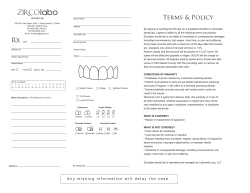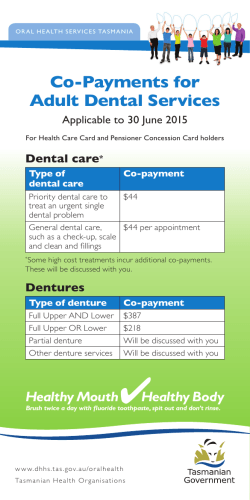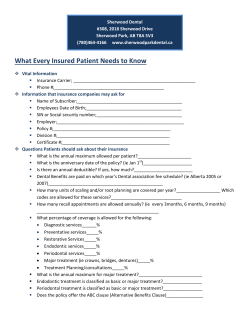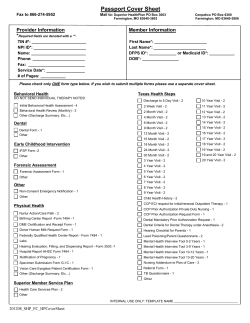
Skilled Occupation List (SOL) 2015-16
Skilled Occupation List (SOL) 2015-16 Tracking Code: AYSBBM Name Individual * Cindy Tilbrook Organisation Australian Dental Prosthetists Association Limited (ADPA) - representing dental prosthetists What are the industry/industries and ANZSCO occupation/s that you or your organisation represents for the purposes of this submission? Industry Health Care and Social Assistance Occupation The three dropdowns below accord with the ABS ANZSCO classification of occupations. Selections are required at the ‘Occupation Group’ 2-digit level and at the ‘Occupation Unit (4-digit)’ level, but can also be made down to the Occupation (6-digit) level depending on the occupation/s to which your submission relates. Additional occupations can be selected by way of the ‘Add item’ button. For each occupation selected, please indicate whether your advice is to Include, Exclude, or is Neutral (other) with respect to the 2015-16 SOL. The rest of the form can be used to provide evidence/reasons to support your recommendations. Attachments can also be added after clicking the 'Submit' button. Item 1 Page 1 of 5 Occupation Group * Health Professionals Occupation Unit * Dental Practitioners Occupation Summary advice for 2015-16 SOL * Include Exclude Neutral Are there any occupations that you represent where there is evidence of imbalances in the demand for and supply of skills in the medium-to-long term? * We represent Dental Prosthetists There is no publicly available reliable data to quantify a response to this question. It is also difficult to quantify a response to this question given that the Information Data Sheet provided combines figures for four quite separate categories of practitioners and we understand that the demographic and other information varies considerably between the practitioner categories. A qualification as a dental technician is the foundation qualification for further study to become a dental prosthetist for some educational pathways (VET sector). Anecdotal evidence suggests that dental technicians are currently experiencing oversupply due to the availability of overseas products purchased directly via the internet. Many technicians report a significant reduction in their levels of business since their profession became deregistered and internet sourcing and supply of products became available. Is there evidence of imbalances in the demand for and supply of skills in the medium-to-long term in non-metropolitan areas? If so, can you indicate in what part of Australia and the number in the occupation in over or undersupply. Page 2 of 5 Yes, the majority of dental prosthetists work in RA classifications 1 and 2, with very low representation in 3 and almost non existent representation in RA 4 and 5. There is high demand for dental prosthetic care in these areas with minimal service delivery. However, there is no supportive evidence which would indicate that the entry of overseas-qualified practitioners will alleviate this situation. Are there any occupations which require formal licensing or registration arrangements in order to practice/perform in this occupation? For example: • Midwives are required to register with the nurses board in their state or territory • Panelbeaters are required to be registered or certified with the state Motor Vehicle Repair Industry Authority Yes. Dental Prosthetists must be registered with the Dental Board of Australia. See comments above about the inability of overseas qualified dental prosthetists to currently obtain registration. Dental technicians do not require any formal licensing or registration. Is it expected that your employment sector will be impacted by any medium-to-long term trends which will impact upon demand and/or supply (excluding costs associated with training, labour hire, and international sponsorship)? Please provide evidence (e.g. data source, policy document) which substantiates these claims. For example: • New benchmarks for childcare centres mandate increased staff-to-child ratios and higher qualification standards for childcare workers. Yes, there are a number of major impacts: 1. Currently there is no pathway for recognition of overseas qualifications for dental prosthetists that would allow them to acquire registration. The Australian Dental Council is currently reviewing this situation with a view to establishing a process for recognition of overseas qualifications. This would then allow overseas-qualified dental prosthetists to apply for registration. 2. There are two competing factors in relation to the impact of dentists on the dental prosthetist profession: a. dentists also can make partial and full dentures and learn these skills in their undergraduate training. The Australian and overseas trend is that new dentist graduates have Page 3 of 5 minimal training in these areas and are increasingly referring this work to dental prosthetists. As the older generation of dentists retire there will be a much smaller proportion of the dentist workforce with significant training in this area and this may place increased pressure on dental prosthetists. b. As a counter to this point, the Australian Dental Association maintains that that there is currently an oversupply of dentists within Australia. Whilst we do not express either agreement or disagreement with this proposition, we do note, that the provision of dental prostheses falls within the scope of practice of dentists as well as dental prosthetists. Should dentists experience a fall demand due to oversupply within the dental profession, there may be a consequent increase in the number of dentists undertaking dental prosthetic work themselves rather than referring patients to dental prosthetists. 3. the age demographic of the Australian population is increasing and the Incidence of edentulism and the demand for dental prostheses is higher in elderly, again placing pressure on the profession in the short-medium term (3 -5 year time period). However, predictions indicate that the rate of edentulism will decline in the longer-term (see Decline of the edentulism epidemic in Australia: Australian Dental Journal 2007; 52;(2); 154-156) and this may have a significant impact on the dental prosthetist profession. 4. the age demographic of the practitioners within the profession is weighted towards the older age group, indicating a higher percentage who are heading into the retirement or preretirement age bracket within the medium – longer term. 5. the demand for dental prosthetists is directly impacted by the availability of government schemes that allow clients to access the services of a dental prosthetist, as there is a strong correlation between overall oral health and socio-economic status and between dental services obtained by those with private health insurance relative to the population as whole. To illustrate, members of our profession saw a significant downturn in business since the cessation of the Chronic Diseases Dental Scheme. However, those engaged in work in the public arena through state-funded schemes face an ongoing and continued demand for services. Please provide any other information you consider relevant evidence to support your submission For example, you may know of some independent studies about your occupation that supports your advice to us. We understand that the report on the Oral Health Workforce being prepared by (the former) Health Workforce Australia is yet to be released. Specific attention should be directed to that report when it is available. Would you like to make any additional comments on the SOL? In our opinion, no change should be made to the SOL for Dental Prosthetists until such time as Page 4 of 5 the results of the Health Workforce Australia project are known and publicly available for consideration. Please provide the name, position and contact details of a person within your organisation who is willing to be contacted if any further information or follow-up is required. Name * Cindy Tilbrook Position * CEI Contact details * [email protected] Ph: 0438 988 772 All information, including name and address details, contained in submissions will be made available to the public on the Department of Industry website unless you indicate that you would like all or part of your submission to remain in confidence. Automatically generated confidentiality statements in emails do not suffice for this purpose. Respondents who would like all or part of their submission to remain in confidence should provide this information in an email to SOL@industry. gov.au . Legal requirements, such as those imposed by the Freedom of Information Act 1982, may affect the confidentiality of your submission. Page 5 of 5
© Copyright 2026









